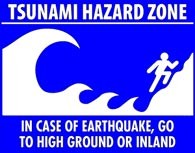Tsunami
ALWAYS CALL 911 if you are in immediate danger and need emergency help.
- Prepare for a tsunami - understand the dangers and what you can do before a disaster.
- Recover from a tsunami - recognize possible environmental hazards and what you can do to protect your safety, and for commercial buildings and schools.
- Latest tsunami messages (NOAA)
Prepare for a tsunami
A tsunami can strike violently and with little warning. Once a warning is issued there may be little time to prepare other than getting to a safe location.
For water and wastewater facilities:
Suggested activities to help facilities prepare. Please note, the linked information is written for hurricane preparedness but much of it can be adapted for any disaster planning.
Planning for disaster debris:
Disasters can generate tons of debris, including building rubble, soil and sediments, green waste (e.g., trees and shrubs), personal property, ash, and charred wood. How a community manages disaster debris depends on the type and amount of debris and the waste management options available. More about planning for disaster debris.
Chemical or fertilizer storage:
Properly designed or modified storage facilities help protect workers' health and safety, and minimize the risk of contamination to land or water.
Hazardous Waste Management Facilities and Units
Pesticides: Containers, Containment, Storage and Disposal of Pesticides
Recover after a tsunami
Expect more waves. Stay away from spills and damaged facilities. Clean up spilled medicines, cleaners and solvents, gasoline or other fuels, or other potentially hazardous substances. More on tsunamis from ready.gov
People get sick or die each year from carbon monoxide or "CO" poisoning due to unsafe use of generators.
- ALERT: Generator exhaust is toxic. Always put generators outside well away from doors, windows, and vents. Never use a generator inside homes, garages, crawlspaces, sheds, or similar areas. Carbon monoxide (CO) is deadly, can build up quickly and linger for hours. More information.
- Listen: Public Service Announcements about carbon monoxide (also en español)
- en español: Proteja su vida y la de su familia: Evite el envenenamiento con monóxido de carbono (español) - conozca los síntomas del envenenamiento con monóxido de carbono.
Indoor air:
Broken gas lines greatly increase the risk of fire, explosion, or poor air quality. If you smell gas, open windows and shut off the main gas line. Notify the utility or other authorities.
Drinking water:
- Boiling water information – To kill all major water-borne bacterial pathogens, bring water to a rolling boil for 1 minute. Boil 3 minutes at elevations above 5280 ft (1 mile or 1.6 km). More about emergency disinfecting drinking water.
- What to do about water from household wells after a flood– Do not turn on the pump due to danger of electric shock. Do not drink or wash with water from the flooded well.
For water and wastewater facilities:
Suggested activities to help facilities recover Please note, the linked information is written for hurricane recovery but much of it will still apply to any recovery activities.
Mold
- Mold cleanup: Mold can cause serious health problems. The key to mold control is moisture control. After the flood, remove standing water and dry indoor areas. Remove and discard anything that has been wet for more than 24-48 hours.
- Mold cleanup in schools and commercial buildings. Information for building managers, custodians, and others who are responsible for commercial building and school maintenance.
- Basic mold hazards. Cleaning up mold. What to wear
- More about mold from Centers for Disease Control
Pesticides, chemical and oil spills, hazardous waste:
- Call the National Response Center 800-424-8802 (24 hours a day every day). For those without 800 access, please call 202-267-2675.
- Industries and businesses that encounter spills or discharges in the aftermath should contact the National Response Center immediately. You or your organization may have legal requirements for reporting or for taking other actions, depending on the spill.
- National Pesticide Information Center: 1-800-858-7378. Pesticide contacts
- How to Report Spills and Environmental Violations
What to do with disaster debris:
How a community manages massive amounts of disaster debris depends on the type and amount debris and the waste management options available.
Burying or burning may not be acceptable unless permission or a waiver has been granted, because of the side effects of smoke and fire from burning, and potential water and soil contamination. Typical methods of recycling and solid waste disposal in sanitary landfills often cannot be applied to disaster debris because of the large volume of waste and reluctance to overburden existing disposal capacity. More information on disaster debris.
Renovation and rebuilding
Lead-safe work: By law, contractors need to use lead-safe work practices on emergency renovations on homes or buildings built before 1978. Activities such as sanding, cutting, and demolition can create lead-based paint hazards. Lead-contaminated dust is harmful to adults, particularly pregnant women, and children.
Asbestos: Anyone working on demolition, removal, and cleanup of building debris needs be aware of any asbestos and to handle asbestos materials properly. People exposed to asbestos dust can develop serious lung health problems including asbestosis, lung cancer and mesothelioma. Although the use of asbestos has dramatically decreased in recent years, it is still found in many residential and commercial buildings and can pose a serious health risk.

